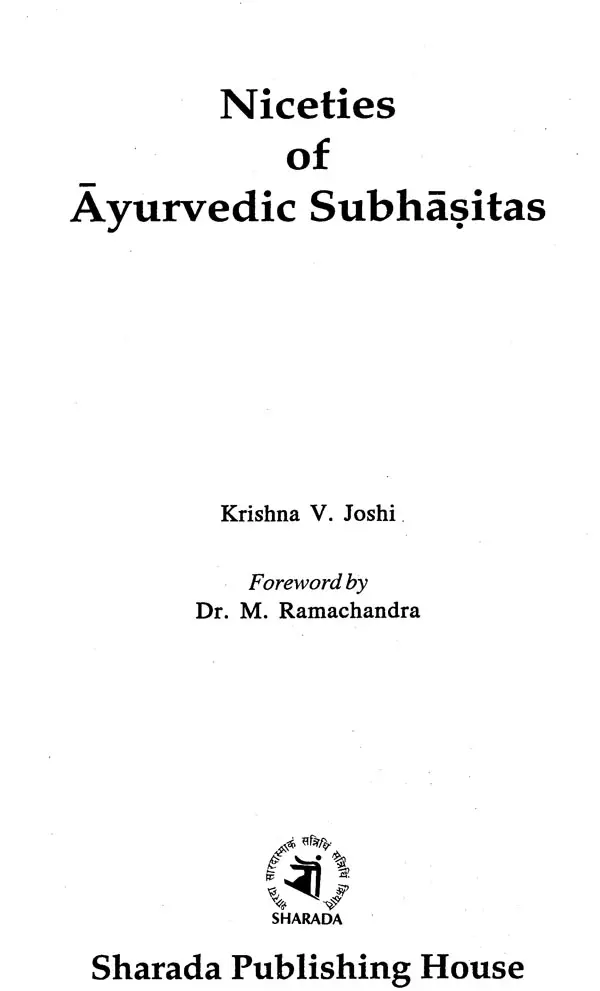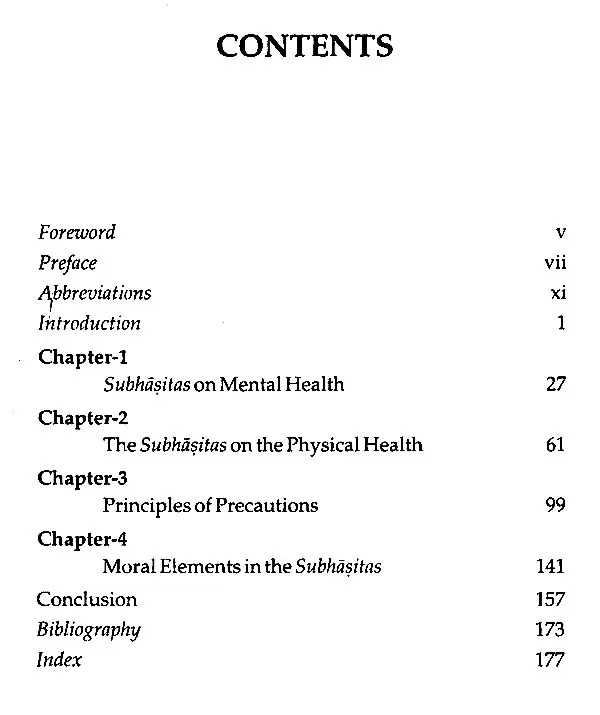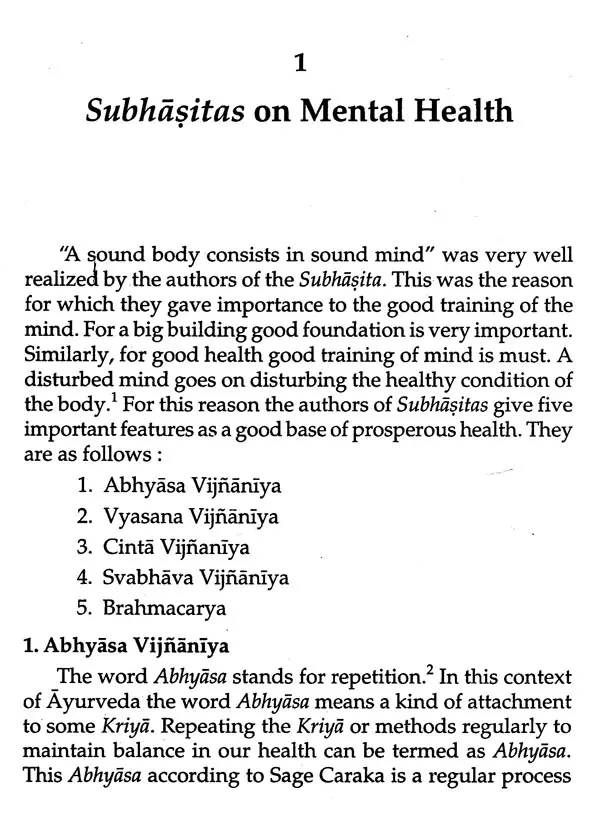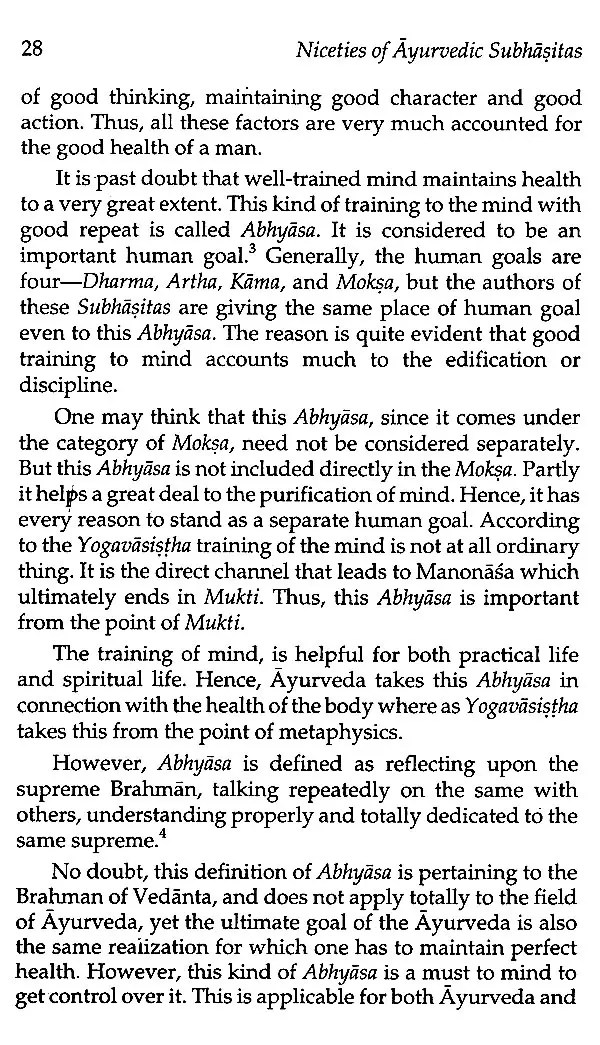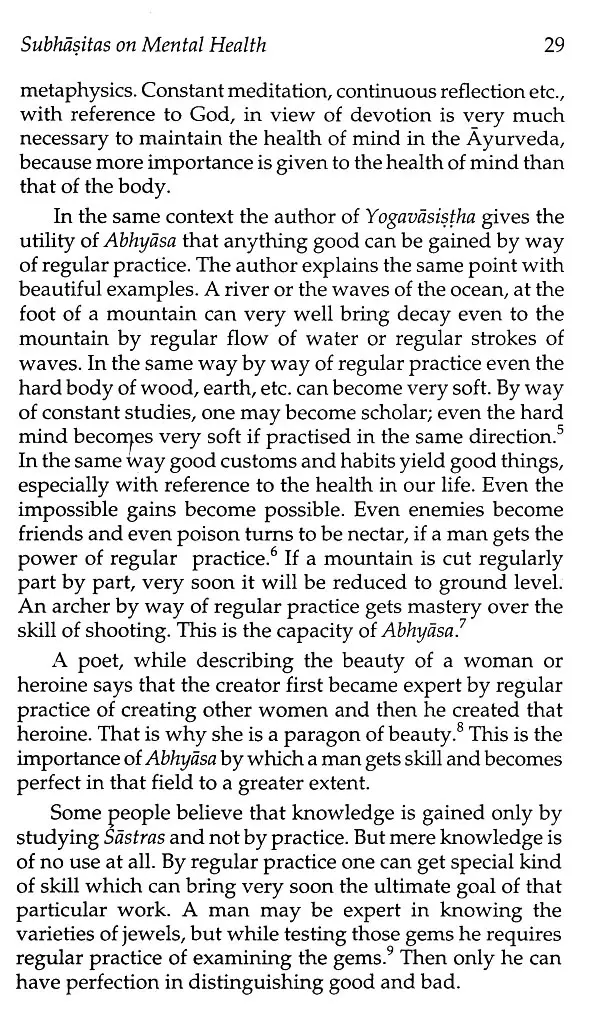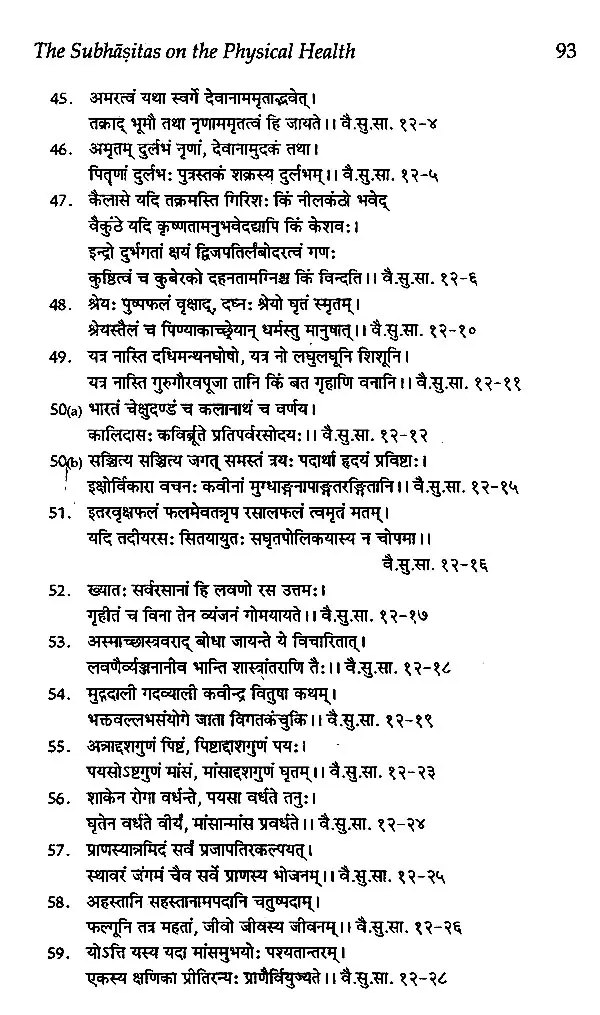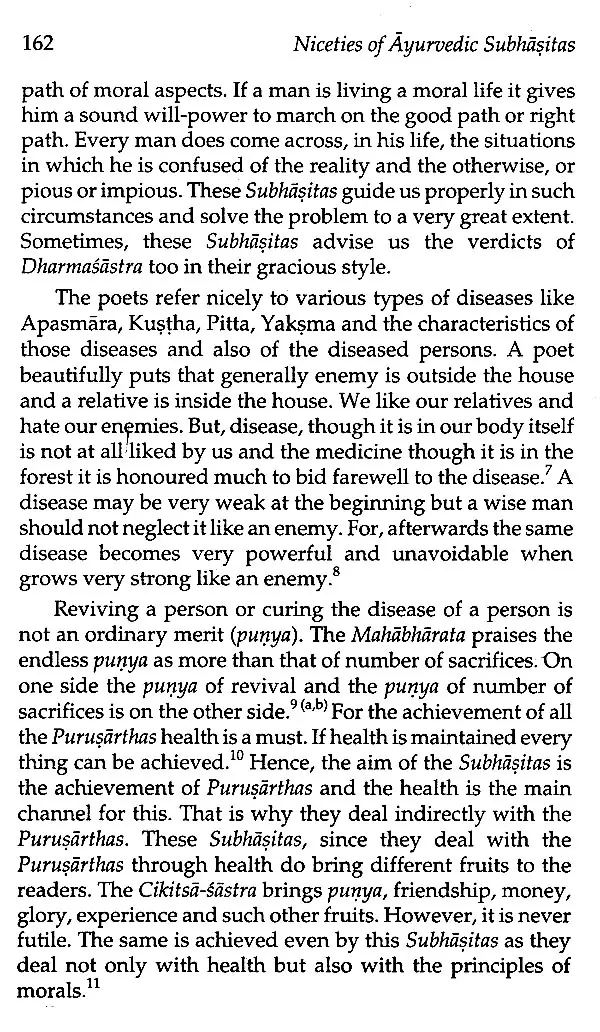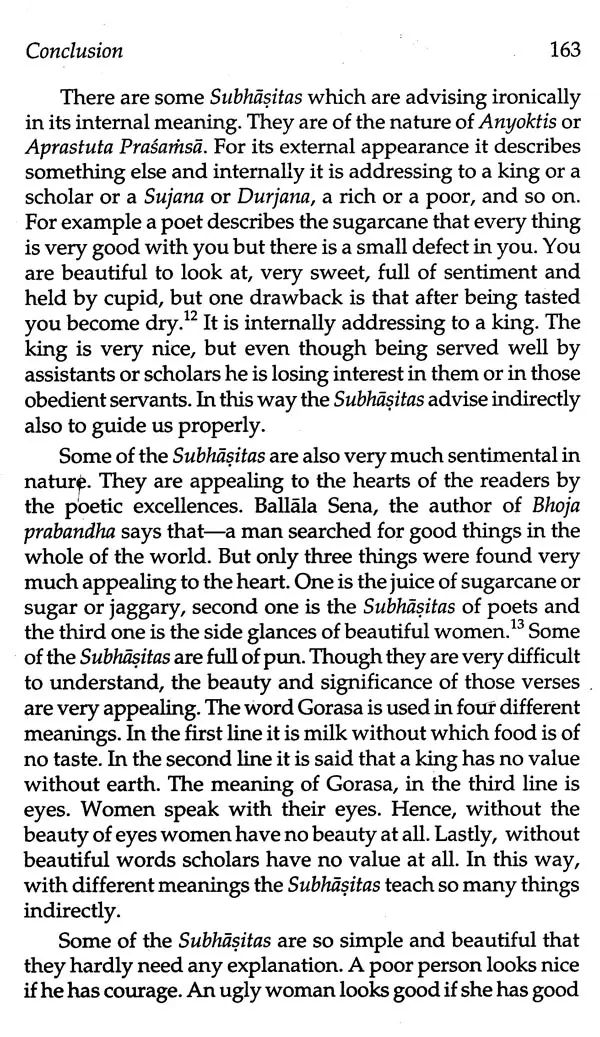
Niceties of Ayurvedic Subhasitas
Book Specification
| Item Code: | UAE983 |
| Author: | Krishna V. Joshi |
| Publisher: | Sharada Publishing House |
| Language: | English and Sanskrit |
| Edition: | 2011 |
| ISBN: | 9788188934720 |
| Pages: | 193 |
| Cover: | HARDCOVER |
| Other Details | 9.00 X 6.00 inch |
| Weight | 350 gm |
Book Description
Ayurveda is the first life science of the world. It is past doubt that the Vedas are the rich sources of various doctrines and sciences in general and the spiritual lories in particular. Among the sciences, the medical science is one of the prime subjects that have enjoyed an enormous dealing. As such a lasting place and name is given to this science among the Upavedas, technically styled as Ayurveda. The reason is quite evident that medicine i the very life of beings, without which one cannot lead a comfortable life in the empiric world.
In fact, the aim of Ayurveda is to provide medical solutions to diseases and to make the being to lead a happy and peaceful life.
Dr. Krishna V. Joshi is a Research Scholar and has been teaching Sanskrit and Prakrit at the Karnatak University's Karnatak College, Dharwad. He has attended national and international seminars, conferences and work-shops. He has bagged gold medal for Sahitya at Shri Shankaracharya Sanskrit Pathashala, Dharwad. He is engaged with his research work in the field of Sanskrit and computer and has contributed many articles and books in Sanskrit, Kannada and English.
Going through the Vidwat Examinations in Sanskrit viz. Vidwat Madhyama (=B.A.) and Vidwat Uttama (=M.A.) in Nyaya and Vedanta, has completed M.A. degree in Sanskrit (2003) and secured second rank in the Karnatak University. He has also secured M.A. degree in Prakrit and Ph.D. on the Ayurvedic Subhashitas.
Ayurveda comprises not only science but culture and philosophy as well. Indian culture is the oldest among all the cultures of the world, and Vedas are the basic source and origin of culture and science. Passing through the ages of the Veda, the Ayurveda was developed in the forms of treaties like Susruta-samhita, Caraka-samhita, a rich treasure of the Ayurveda was stored in these books.
At a later date poets, scholars and some physicians collected a few important verses from the Ayurveda to explain the values of the medicines in many different contexts. Poets mingled these medical aspects with poetic excellencies. In simple verses, both medical aspects and poetic beauty were going hand in hand. Thus, they were treated as Subhasitas. These are the cream of those literary pieces along with the moral lessons or ethical points. Some points of health are also included in these Subhasitas. Thus, Subhasitas have become a good mixture of poetic beauty, ethics and medical aspects. These Subhasitas were presented in a mass and collected in the form of treaties. Each and every Subhasita is a separate unit. It gives a complete idea in itself. Hence, they are also called muktakas.
Today human beings are going away from the nature and his own intellect due to which he is deprived of his natural state of health. Guidelines of Ayurveda Subhasitas are necessary to get back the healthy body, pure mind, and intellect. The reason is quite simple that Ayurveda which links the human beings with nature and his intellect within and gives awareness about the best life style.
As the early chapters of this book begun with the aspects like, Subhasitas on mental health, physical health and principles of precautions. At the end, how the moral elements shape, the life style of a person is prescribed in a poetic way.
The present monograph puts light on medical as well as ethical aspects of Ayurveda Subhasitas. The author has communicated many of the basic truths of this profound philosophical science in a readily understandable manner. The attempt of t e present author Dr. K.V. Joshi deserves real praise from readers of the Indian System of Ayurveda which are now attracting international attention.
The Subhasitas are the cream of Sanskrit literature. They are picked with good morals in decorus style. Some of these Subhasitas abound in good many elements of health, both physical and mental. They are collected seperately in a book by Dr. Bhaskar Govind Ghanekar and were named after the same, i.e. Ayurvediya Subhasita Sahitya or Vaidyakiya Subhasita Sahitya. Elements of health and poetic excellences go hand in hand in these Ayurvedic Subhasitas. They are careful choices in beauty and matter as such they are appealing to the heart of readers of all the times.
They advise us to adopt precautions like Mitahara, Parisrama, Pranayama, Asanas and others against the diseases to maintain perfect health. They guide us in all walks of our life to lead a successful life.
Many scholars have encouraged me at different stages of this study. Primarily, it has been my good fortune to have been associated with Dr. Ramachandra (M.A., Ph.D.), Professor and Chairman Department of Post-Graduate Studies and Research in Philosophy, University of Mysore, Manasagangotri, Mysore for having graced this work Niceties of Ayurvedic Subhasitas with his valuable foreword. I owe a very great debt of gratitude to him for the illuminating suggestions and for the keen interest and cave with which he scrutinized this work.
I also place on record my sincere thanks to Dr. M.N. Joshi, Professor and Chairman Department of Studies in Sanskrit Karnatak University, Dharwad for his help and encouragement.
I also respectfully mention the name of my venerable 'Guru' Dr. Venimadhavashastri B. Joshi, Department of Sanskrit, Prakrit and Yoga, Karnatak College, Dharwad. His teachings, full of ease and grace exerted remarkable influence on me to ease down the force of difficulty of this undertaking. There are no adequate words to express my high sense of gratitude to him. I simply record my greatest esteem by paying to him my homage.
Lastly, thanks to Anjana Bansal of Sharada Publishing House, Delhi for completing the printing in a shortest possible time. My efforts embolden me to seek good response from the readers.
The Ayurvedic Subhasitas guide us on all walks of our life and shape the future of our life with prosperous health if their advices are implemented properly. The compilation of Ayurvedic Subhasitas in Sanskrit literature, is a new field in which we have a good collection of Subhasitas pertaining to the principles of fruitful life in general and of health in particular. This tradition of collecting the Subhasitas on the various facts of health started a new dimension in the field of Sanskrit literature. It is just bifurcating the Subhasitas on health from the famous works of great poets and also from the famous collections of Subhasitas like satakatraya, Subhasitaratna Bhandagara, Subhasita Sudhanidhi and others.
Among the modern collections the Vaidyakiya Subhasita Sahitya or Sahityika Subhasita Vaidyakam compiled by Dr. Bhaskar Govind Ghanekar Vaidya of the present days is one of the important work in this field that invites a thorough study. The present theme is a humble study of the same work.
Ayurveda is the first life science of the world. It is a holistic system of medicine that is indigenous to and widely practised in India. The word Ayurveda is a Sanskrit term meaning science of life. Ayu means Life or daily living and the Veda is knowledge.1 The Ayurveda was first recorded in the Vedas, the oldest extent literature of the world. This healing system has been practised in daily life in India for more than 5000 years.
It is past doubt that the Vedas are the rich sources of various Doctrines and sciences in general and the spiritual lores in particular. Among the sciences the medical science is one of the prime subjects that have enjoyed an enormous dealing. As such a lasting place and name is given to this science among the Upavedas, technically styled as Ayurveda. The reason is quite evident that medicine is the very life of beings, without which one cannot lead a comfortable life in the empiric world.2
The medicine carries air importance in our life, because the intestines of a being in general and of a human being in particular are far away from the reach of perceptual sense organs. As such the significance of medicines in doing away with the hard effects or slight changes or deformations in the body, is much realized in ancient days. Thus, it is found that necessity is the mother of invention. This kind of dire need for medical solutions encouraged many discoveries which formed a bedrock for the history of medicines. It is clearly traced in the Vedic literature which later took shape of a system, technically known as Ayurveda.
In fact, the aim of Ayurveda is to provide medical solutions to diseases and to make the being to lead a happy and peaceful life.3
Lord Brahma has made the arrangement of medical solutions right from the beginning of creation, for diseases are born along with the bodies of the beings. In other words, according to Caraka the Ayurveda is beginning less (anadi).4
Susruta finds that Brahma delivered it even before creations5, for it is a must for every being to sustain the life and make it easily handled with good health. Thus, the same tradition has come down to the present time without any break. There may be some change in formation and content, but the central point and core remained the same.
Some scholars think that there was a great deal of influence of the foreign countries like Europe and Arab (Yunani), but, it is far away from the truth. On the contrary it is nearer to the fact that Indian medical science had influenced enormously on the other countries in the past.
The fragments of the Vedic culture are clearly traced in the civilizations of Bebilonian, Cambodia, Syria, Philistine, Sumerian, Aserian and some other places in which Indian Vedic names like Indra, Candra, Varuna, Delipa (Dreleep) Sagara (Shagar) and others. It is believed that along with these cultural points some tenets of medical sciences too might have readied the foreign countries, the references of which/ are pertinent in the footprints of history.
Thus, the tenets of medical science are found in detail in the Atharvaveda which is considered to be the oldest cannon of the world. In the days of Atharvaveda treatments for diseases were done in two ways.
1. By way of plants and medical components, and
2. By way of Mantras and Tantras to appears the anger of some gods.6
The same method was followed even in the ancient tradition of Rome and Europe (Tuton). There is least doubt that the neighbouring countries like China and others were in close connection with India for which diseases born after 400 B.C. were noted in the treasuries of China. In fine it can safely be concluded that the eminence of medical science was found first in India and was developed to a great extent and was transferred to other countries too along with some facts of Indian culture.
